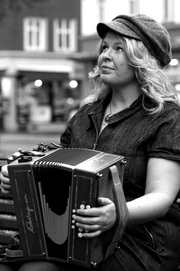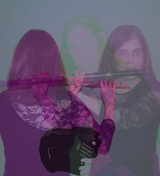It’s been a weekend of astonishing music from across the North Sea and Iceland. Northern Streams, now in its ninth year, never fails to inspire me with the diverse and excellent music showcased. What did surprise me was the different paths that the Swedish and Norwegians musicians have taken to arrive in their music.
Melodeon player Rannveig Djønne’s performance with singer and hardanger player, Annlaug Borsheim, in Saturday evening’s concert was an example of sheer beauty in simplicity. At Saturday afternoon’s last workshop, Rannveig Djønne was disarmingly unassuming. She commented on her lack of musical training, but added that she did know the names of the harmony buttons on her three differently tuned melodeons! The first Norwegian to play her country’s traditional music on the melodeon, she recounted how she attended the traditional music college some 29 years ago. And then she played Bambas, a lullaby written for her oldest niece (and told a story about writing a more fiery tune for her younger niece, a “little viking”). We were all blown away by the sheer beauty, of the tune, of her playing, of the arrangement. It was the most beautiful melodeon playing I have ever heard, her use of the fully extended bellows was amazing. Click on the picture to have a listen - her music will stay with me forever.
Melodeon player Rannveig Djønne’s performance with singer and hardanger player, Annlaug Borsheim, in Saturday evening’s concert was an example of sheer beauty in simplicity. At Saturday afternoon’s last workshop, Rannveig Djønne was disarmingly unassuming. She commented on her lack of musical training, but added that she did know the names of the harmony buttons on her three differently tuned melodeons! The first Norwegian to play her country’s traditional music on the melodeon, she recounted how she attended the traditional music college some 29 years ago. And then she played Bambas, a lullaby written for her oldest niece (and told a story about writing a more fiery tune for her younger niece, a “little viking”). We were all blown away by the sheer beauty, of the tune, of her playing, of the arrangement. It was the most beautiful melodeon playing I have ever heard, her use of the fully extended bellows was amazing. Click on the picture to have a listen - her music will stay with me forever.
Similarly, singer and hardanger player, Lajla Buer Storli, told us in her Saturday morning workshop, that she doesn’t read music, and has minimal music theory. To learn some of the oldest Norwegian tunes on manuscript, her husband plays them from the sheet music, and she then learns them by ear from him. In her workshop, she taught us an old Halling and a waltz that she believed may have come from the UK, by way of the tourist boats that visited Norway, resulting in cross-cultural music influences. Ditte Mortensen, fiddle player with Danish Bornholm-based band, Habbadam, has previously expressed a similar belief in the way that Bornholm’s eighteenth century music seems to have a link with Scottish baroque music.
Fiddle player Emma Reid and saxophonist Daniel (formerly Carlsson) Reid have come to their music from more “conventional” routes. I first met Daniel at Northern Streams three years ago, when he performed as part of the band, One Fine Day, and co-taught a flute workshop with the scottish wooden flute player, Calum Stewart. This year he performed with his wife Emma who was born in Northumberland to a Swedish mother and moved to Sweden 12 years ago. The combination of fiddle and saxophone is unusual but works extremely well. In the afternoon workshop, the Emma taught us a lovely slang polska, and then Daniel demonstrated modal drones and rhythmic riffs as effective harmonies. Daniel has a broad background in classical music as well as jazz and folk, and teaches at the Royal College of Music in Stockholm while Emma graduated from Newcastle University and then the Royal College of Music in Stockholm. Their music is firmly rooted in the Swedish tradition, imbued with rhythm but at the same time articulate and with well-honed technique.
For me, the stars of Friday night’s concert were Karin Ericsson Back and Maria Misgeld. Singing acapella. Two of three members of the band Irmelin, their harmonies and canons were entrancing. They committed wholly to the music and were a joy hear.
All of these Nordic musicians are so generous with their time and their art. They invited us whole-heartedly into their music, sharing with us as they themselves have had other traditions share with them. Shetland’s music is acknowledged as a continuing influence, as are the other nordic countries. The only disappointing thing about Northern Streams 2012 was the paucity of the audience in both the concerts and the workshops. Northern Streams is such a great opportunity to expand musical horizons. Why are so few of us interested in engaging with our northern neighbours...
Fiddle player Emma Reid and saxophonist Daniel (formerly Carlsson) Reid have come to their music from more “conventional” routes. I first met Daniel at Northern Streams three years ago, when he performed as part of the band, One Fine Day, and co-taught a flute workshop with the scottish wooden flute player, Calum Stewart. This year he performed with his wife Emma who was born in Northumberland to a Swedish mother and moved to Sweden 12 years ago. The combination of fiddle and saxophone is unusual but works extremely well. In the afternoon workshop, the Emma taught us a lovely slang polska, and then Daniel demonstrated modal drones and rhythmic riffs as effective harmonies. Daniel has a broad background in classical music as well as jazz and folk, and teaches at the Royal College of Music in Stockholm while Emma graduated from Newcastle University and then the Royal College of Music in Stockholm. Their music is firmly rooted in the Swedish tradition, imbued with rhythm but at the same time articulate and with well-honed technique.
For me, the stars of Friday night’s concert were Karin Ericsson Back and Maria Misgeld. Singing acapella. Two of three members of the band Irmelin, their harmonies and canons were entrancing. They committed wholly to the music and were a joy hear.
All of these Nordic musicians are so generous with their time and their art. They invited us whole-heartedly into their music, sharing with us as they themselves have had other traditions share with them. Shetland’s music is acknowledged as a continuing influence, as are the other nordic countries. The only disappointing thing about Northern Streams 2012 was the paucity of the audience in both the concerts and the workshops. Northern Streams is such a great opportunity to expand musical horizons. Why are so few of us interested in engaging with our northern neighbours...


 RSS Feed
RSS Feed